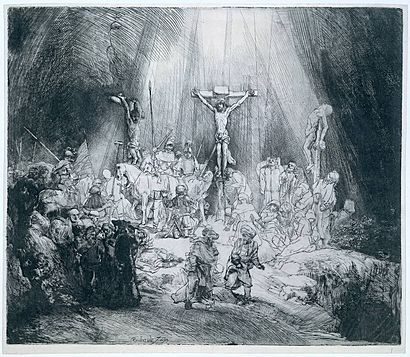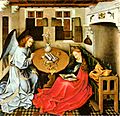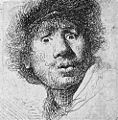Old master print facts for kids

An old master print is a type of artwork made using a printing process. These prints were mostly created before the year 1830. After that time, new ones were no longer made. The main ways artists made these prints were using woodcut, engraving, and etching techniques. Most old master prints were made on paper.
Many famous European artists were also printmakers. These include Albrecht Dürer, Rembrandt, and Francisco Goya.
Contents
What Are Old Master Prints?
Old master prints are original artworks, not just copies. They were made by artists who used special methods to create many identical images. These images could then be shared or sold. Think of them as early forms of mass media.
How Were They Made?
Artists used different techniques to create old master prints. Each method had its own unique look and feel.
Woodcut Prints
A woodcut is one of the oldest printing methods. Artists would carve an image into a block of wood. They would remove the parts of the wood they didn't want to print. The raised parts of the wood block would then be covered with ink. When pressed onto paper, only the inked parts would transfer, creating the image.
Engraving Prints
Engraving is a technique where an artist uses a sharp tool called a burin. They cut lines directly into a metal plate, usually copper. The deeper the cut, the darker the line will appear in the print. After cutting, ink is rubbed into these lines. The surface of the plate is wiped clean, leaving ink only in the grooves. When pressed, the paper picks up the ink from the lines.
Etching Prints
Etching also uses a metal plate, but the process is different. The plate is first covered with a special acid-resistant wax or resin. The artist then draws their design into this coating with a needle. This exposes the metal underneath. The plate is then dipped into acid. The acid "bites" or eats away at the exposed metal lines, creating grooves. After the acid bath, the coating is removed. Ink is then applied and printed in a similar way to engraving. Etching often allows for more fluid and sketch-like lines than engraving.
Famous Old Master Printmakers
Many of the greatest artists in history were also masters of printmaking. They used these techniques to create some of their most famous works.
Albrecht Dürer
Albrecht Dürer was a German artist from the 15th and 16th centuries. He was a master of both woodcut and engraving. His prints are known for their incredible detail and powerful images. He often signed his prints with his famous "AD" monogram.
Rembrandt van Rijn
Rembrandt was a Dutch painter from the 17th century. He was also a brilliant etcher. He used etching to create portraits, landscapes, and scenes from the Bible. Rembrandt was very skilled at showing light and shadow in his prints. He often experimented with different ways to ink his plates.
Francisco Goya
Francisco Goya was a Spanish artist who lived in the late 18th and early 19th centuries. He created many powerful and sometimes dark prints. His series like "The Disasters of War" showed the horrors of conflict. Goya used etching and aquatint (another printmaking technique) to create his dramatic works.
Why Are Old Master Prints Important?
Old master prints are important for several reasons. They allowed artists to share their ideas with more people. Before printing, artworks were unique and expensive. Prints made art more accessible. They also helped spread new artistic styles and ideas across Europe.
These prints also give us a look into the past. They show us what life was like, what people believed, and how artists saw the world centuries ago. They are a valuable part of art history.
Images for kids
-
Melencolia I, 1514, engraving by Albrecht Dürer
-
A woodcut of St Christopher dated 1423 (southern Germany); John Rylands Library
-
A woodcut of St Christopher dated 1423 (southern Germany); John Rylands Library
-
Reproductive engraving by Jacob Matham, in this case of a sculpture, Moses, by Michelangelo, 1593
-
The Milkmaid, engraving by Lucas van Leyden, 1510
-
The Little Fool by Sebald Beham, 1542, 4.4 x 8.1 cm
-
Hercules, engraving by Giorgio Ghisi, after Bertani, 1558
-
The Farnese Hercules, engraving by Goltzius
-
Self-portrait by Rembrandt, 1630
-
"The Raising of Lazarus", etching by Castiglione
-
One of Piranesi's views of Rome














